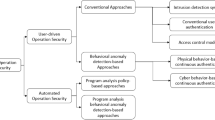Abstract
Increasing concerns about the potential for privacy breaches cast doubt on the future of smart homes. Specifically, wireless snooping-based attacks that target home networks have demonstrated their capacity to illegitimately infer daily activities within the home. This paper reviews the fundamental strategies for safeguarding the personal data of the home residents and evaluates the efficacy of existing privacy-protecting solutions that are built upon the reviewed strategies. The study will show that, while some solutions established a reliable level of home data privacy protection, their negative effects on other system characteristics are significant, emphasizing the need for an ideal compromise between these elements. These factors are the provided privacy rate, impact on the system’s response time, and energy consumption of privacy-protecting approaches. This overview of current research will aid in understanding the existing drawbacks and indicate potential avenues for future research.
Access this chapter
Tax calculation will be finalised at checkout
Purchases are for personal use only
Similar content being viewed by others
References
Xu, W., et al.: The design, implementation, and deployment of a smart lighting system for smart buildings. IEEE Internet Things J. 6(4), 7266–7281 (2019)
Haney, J.M., Furman, S.M., Acar, Y.: Smart home security and privacy mitigations: consumer perceptions, practices, and challenges. In: Moallem, A. (ed.) HCII 2020. LNCS, vol. 12210, pp. 393–411. Springer, Cham (2020). https://doi.org/10.1007/978-3-030-50309-3_26
Tabassum, M., Kosinski, T., Lipford, H.R.: “I don’t own the data”: end user perceptions of smart home device data practices and risks. In: Fifteenth Symposium on Usable Privacy and Security (SOUPS 2019) (2019)
Dasgupta, A., Gill, A.Q., Hussain, F.: Privacy of IoT-enabled smart home systems. In: Internet of Things (IoT) for Automated and Smart Applications, p. 9. IntechOpen, London (2019)
Abrishamchi, M.N., et al.: A probability based hybrid energy-efficient privacy preserving scheme to encounter with wireless traffic snooping in smart home (2017)
Naru, E.R., Saini, H., Sharma, M.: A recent review on lightweight cryptography in IoT. In: 2017 International Conference on I-SMAC (IoT in Social, Mobile, Analytics and Cloud) (I-SMAC). IEEE (2017)
Abrishamchi, M.A.N., et al.: Side channel attacks on smart home systems: a short overview. In: IECON 2017–43rd Annual Conference of the IEEE Industrial Electronics Society. IEEE (2017)
Srinivasan, V., Stankovic, J., Whitehouse, K.: Protecting your daily in-home activity information from a wireless snooping attack. In: Proceedings of the 10th International Conference on Ubiquitous Computing (2008)
Noto, M., Sato, H.: A method for the shortest path search by extended Dijkstra algorithm. In: SMC 2000 Conference Proceedings. 2000 IEEE International Conference on Systems, Man and Cybernetics. ‘Cybernetics Evolving to Systems, Humans, Organizations, and Their Complex Interactions’. IEEE (2000)
Saeed, N., et al.: A survey on multidimensional scaling. ACM Comput. Surv. (CSUR) 51(3), 1–25 (2018)
Teknomo, K.: K-means clustering tutorial. Medicine 100(4), 3 (2006)
Roughgarden, T., Cs261: A second course in algorithms, lecture# 5: Minimum-cost bipartite matching (2016)
Nassiri Abrishamchi, M.A., et al.: Smart home privacy protection methods against a passive wireless snooping side-channel attack. Sensors 22(21), 8564 (2022)
Alomair, B., et al.: Toward a statistical framework for source anonymity in sensor networks. IEEE Trans. Mob. Comput. 12(2), 248–260 (2011)
Zou, Y., et al.: A survey on wireless security: technical challenges, recent advances, and future trends. Proc. IEEE 104(9), 1727–1765 (2016)
Jeba, S., Paramasivan, B.: False data injection attack and its countermeasures in wireless sensor networks. Eur. J. Sci. Res. 82(2), 248–257 (2012)
Yang, Y., et al.: Towards statistically strong source anonymity for sensor networks. ACM Trans. Sens. Netw. (TOSN) 9(3), 1–23 (2013)
Park, H., Park, T., Son, S.H.: A comparative study of privacy protection methods for smart home environments. Int. J. Smart Home 7, 85–94 (2013)
He, J., et al.: An adaptive privacy protection method for smart home environments using supervised learning. Future Internet 9(1), 7 (2017)
Acknowledgment
This research was financially supported by the Research Excellence Consortium in IoT Security fund from Ministry of Higher Education Malaysia. The research grant number: JPT(BKPI)1000/016/018/25(49).
Author information
Authors and Affiliations
Corresponding author
Editor information
Editors and Affiliations
Rights and permissions
Copyright information
© 2023 The Author(s), under exclusive license to Springer Nature Singapore Pte Ltd.
About this paper
Cite this paper
Nassiri Abrishamchi, M.A., Zainal, A. (2023). Review of Smart Home Privacy-Protecting Strategies from a Wireless Eavesdropping Attack. In: Wah, Y.B., Berry, M.W., Mohamed, A., Al-Jumeily, D. (eds) Data Science and Emerging Technologies. DaSET 2022. Lecture Notes on Data Engineering and Communications Technologies, vol 165. Springer, Singapore. https://doi.org/10.1007/978-981-99-0741-0_11
Download citation
DOI: https://doi.org/10.1007/978-981-99-0741-0_11
Published:
Publisher Name: Springer, Singapore
Print ISBN: 978-981-99-0740-3
Online ISBN: 978-981-99-0741-0
eBook Packages: Intelligent Technologies and RoboticsIntelligent Technologies and Robotics (R0)




